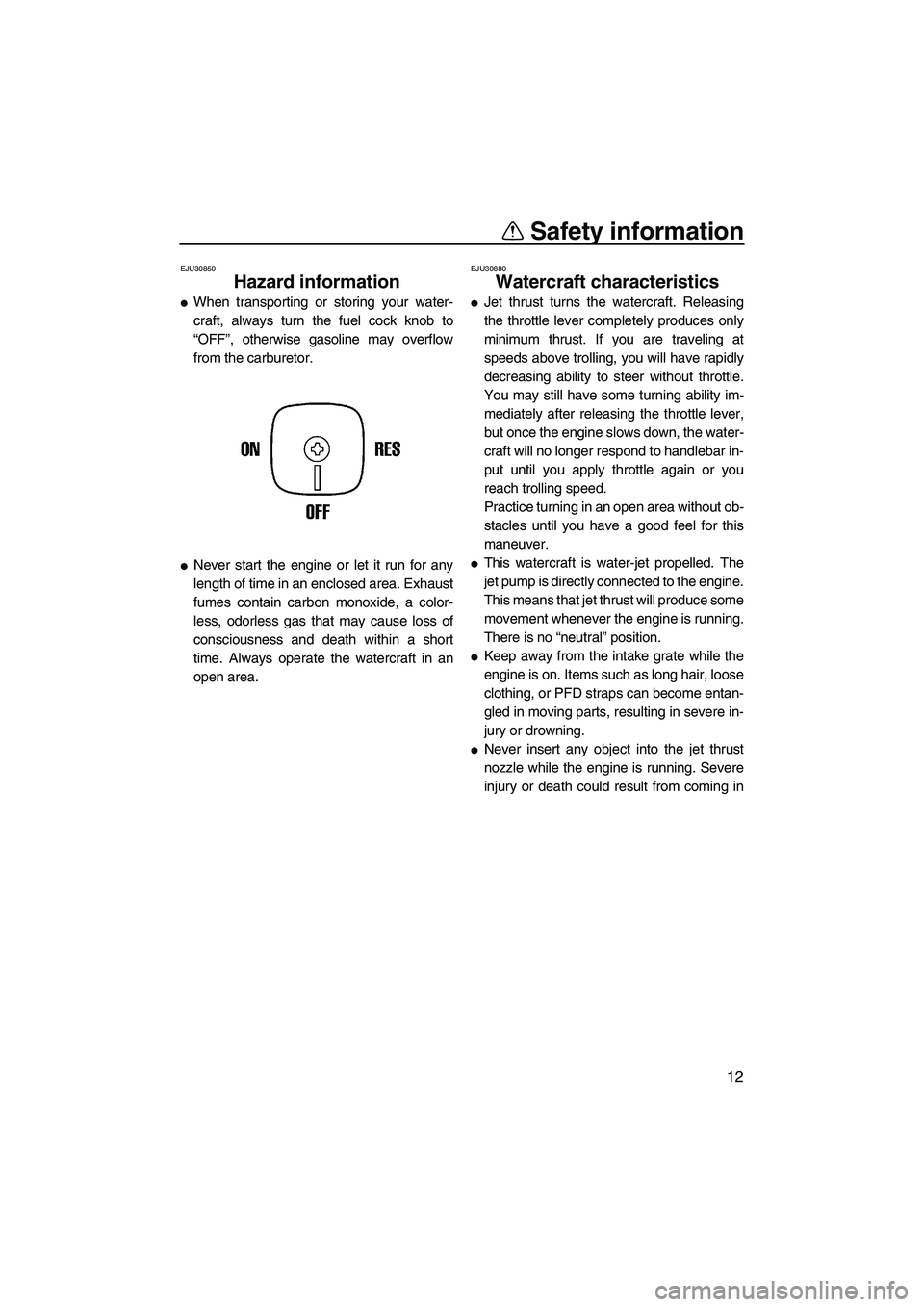Page 3 of 78
Important manual information
EJU30083
– JP 19 E 01 0 00 H YAM
Product identification:
Product : Personal Watercraft
Brand : YAMAHA
Model / Commercial name: SJ700B-J / SuperJet
Model specifics:
Length: 2.24 (meters)
Width: 0.68 (meters)
Engine make: 6BA
Engine type: petrol
Power: 48.5 (kW)
Construction Material: Hull: SMC, Deck: HLU
Max. persons: 1
Starting CIN of this model:
Manufacturer:YAMAHA MOTOR CO., LTD.
2500 Shingai, Iwata
Shizuoka, 438-8501
Japan
EU Representative:YAMAHA MOTOR EUROPE N.V.
Koolhovenlaan 101
Schiphol-Rijk, 1119 NC
The Netherlands
DECLARATION OF CONFORMITY
UF2F72E0.book Page 1 Friday, May 22, 2009 5:11 PM
Page 19 of 78

Safety information
12
EJU30850
Hazard information
�When transporting or storing your water-
craft, always turn the fuel cock knob to
“OFF”, otherwise gasoline may overflow
from the carburetor.
�Never start the engine or let it run for any
length of time in an enclosed area. Exhaust
fumes contain carbon monoxide, a color-
less, odorless gas that may cause loss of
consciousness and death within a short
time. Always operate the watercraft in an
open area.
EJU30880
Watercraft characteristics
�Jet thrust turns the watercraft. Releasing
the throttle lever completely produces only
minimum thrust. If you are traveling at
speeds above trolling, you will have rapidly
decreasing ability to steer without throttle.
You may still have some turning ability im-
mediately after releasing the throttle lever,
but once the engine slows down, the water-
craft will no longer respond to handlebar in-
put until you apply throttle again or you
reach trolling speed.
Practice turning in an open area without ob-
stacles until you have a good feel for this
maneuver.
�This watercraft is water-jet propelled. The
jet pump is directly connected to the engine.
This means that jet thrust will produce some
movement whenever the engine is running.
There is no “neutral” position.
�Keep away from the intake grate while the
engine is on. Items such as long hair, loose
clothing, or PFD straps can become entan-
gled in moving parts, resulting in severe in-
jury or drowning.
�Never insert any object into the jet thrust
nozzle while the engine is running. Severe
injury or death could result from coming in
UF2F72E0.book Page 12 Friday, May 22, 2009 5:11 PM
Page 69 of 78

Specifications
62
EJU34542
Specifications
Watercraft capacity:
Maximum people on board:
1 person
Dimensions:
Length:
2240 mm (88.2 in)
Width:
680 mm (26.8 in)
Height:
660 mm (26.0 in)
Dry weight:
139 kg (306 lb)
Performance:
Maximum output (according to ISO 8665/SAE
J1228):
48.50 kW@6250 r/min
Maximum fuel consumption:
29.0 L/h (7.7 US gal/h, 6.4 Imp.gal/h)
Cruising range at full throttle:
0.62 hour
Trolling speed:
1300 ±50 r/min
Engine:
Engine type:
2-stroke
Number of cylinders:
2
Engine displacement:
701 cm³
Bore & stroke:
81.0 × 68.0 mm (3.19 × 2.68 in)
Compression ratio:
7.2 : 1
Lubrication system:
Pre-mixed fuel and oil
Cooling system:
Water
Starting system:
Electric
Ignition system:
C.D.I.
Spark plug:
BR7HS
Spark plug gap:
0.6–0.7 mm (0.024–0.028 in)
Battery capacity:
12 V, 19.0 AhCharging system:
Flywheel magneto
Drive unit:
Propulsion system:
Jet pump
Jet pump type:
Axial flow, single stage
Impeller rotation:
Counterclockwise
Jet thrust nozzle angle:
P1: 14.4+14.4°
P2: 17.3+17.3°
Fuel and oil:
Recommended fuel:
Regular unleaded gasoline
Minimum octane rating (PON):
86
Minimum octane rating (RON):
90
Recommended engine oil:
YAMALUBE 2-W or TC-W3 outboard motor
oil or equivalent
Fuel mixing ratio (fuel to oil):
50 :1
Fuel tank total capacity:
18 L (4.8 US gal, 4.0 Imp.gal)
Fuel tank reserve capacity:
5.5 L (1.5 US gal, 1.2 Imp.gal)
UF2F72E0.book Page 62 Friday, May 22, 2009 5:11 PM
Page 74 of 78

Trouble recovery
67
(4) Open the fuse holder and replace the
fuse with one of the correct amperage.
WARNING! Do not use fuses of higher
amperage than recommended. Substi-
tution with a fuse that has an improper
rating can cause extensive electrical
system damage and possible fire.
[EWJ00801]
(5) Insert the fuse holder into the electrical
box.
(6) Install the cap and tighten it securely.
(7) Install the hood in its original position.
EJU34703Towing the watercraft
WARNING
EWJ00811
�The operator of the towing boat must
keep speed to a minimum and avoid traf-
fic or obstacles which could be a hazard
to the operator on the watercraft.
�The towline should be long enough so
that the watercraft will not collide with
the towing boat when slowing down.
If the watercraft becomes inoperative in the
water, it can be towed to shore.
To tow the watercraft:
Use a towline that is three times the combined
length of the towing boat and the watercraft.
(1) Securely attach the towline to the bow
rope hole of the watercraft being towed.
(2) Ride the watercraft with your body weight
supported on the riding tray. Hold on to
the handlebars in order to balance the
watercraft and keep the bow up out of the
water. NOTICE: The bow must be kept
up out of the water during towing, oth-
erwise water could flood the engine
compartment or water could flow back
into the engine, causing severe en-
gine damage.
[ECJ01330]
Tow the watercraft at 5 mph (8 km/h) or less.
NOTICE: Tow the watercraft at 5 mph (8
km/h) or less, otherwise water could flood
the engine compartment or water could
flow back into the engine, causing severe
engine damage.
[ECJ01320]
EJU34733
Submerged watercraft
If the watercraft is submerged or flooded with
water, drain the water from the engine com-
partment. Then, have a Yamaha dealer ser-
vice the watercraft as soon as possible.
(1) Remove the watercraft from the water,
and then remove the hood.
1Fuse holder
2Electrical box
3Fuse
4Cap
Fuse amperage:
Battery fuse:
10 A
1Bow rope hole
UF2F72E0.book Page 67 Friday, May 22, 2009 5:11 PM